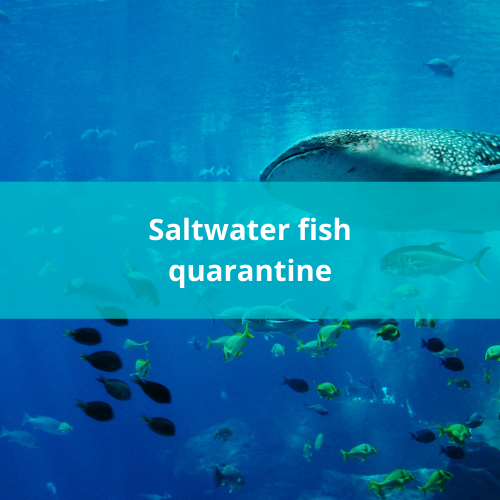![]()
What is the purpose of quarantine?
- Allow your fish to get used to being in captivity in a safe environment.
To provide a controlled environment for the treatment of common diseases and parasites.
To lessen the acclimation stress.
Reduce the costs of keeping S/W fish by lowering fish mortality.
To make it easier to observe new fish in the event of disease.
Medication costs should be reduced.
These are just a few of the reasons why you should quarantine your fish. Most local fish stores will do their best not to spread disease or parasites, but we occasionally end up with diseased fish despite their best efforts. There are some things we can do as customers to reduce the chances of problems, but nothing is perfect.
- Place a deposit on the fish and have it held for a week at the store.
Never buy a fish without first watching it eat.
Keep an eye out for signs of disease or parasites.
Look for disease and/or parasites in the other fish in the same holding tank.
Never purchase a fish on the same day that it is delivered to the store.
Inquire with the store if the fish are quarantined before being sold.
Know what fish you already have in your tank and what fish you want to add.
Learn about the dietary requirements of the fish you’re considering.
Use the proper acclimation methods.
For around $30.00, you can set up a basic quarantine system.
Purchase a sponge filter and an air pump (the filter will set you back around $8.00 and the air pump will set you back around $6.00). Place a deposit on the fish you want and start running the sponge filter in your sump in the display tank for a week before you pick up your new fish.
Fill a 10-gallon tank (which can be found for around $10.00) with water from the display tank. Place the sponge filter in the 10-gallon tank, along with some decorations (I used large PVC fittings) to provide a hiding place for the fish. Use a heater to keep the temperature stable; in a 10g tank, I’d use a 50W heater, but it could be as low as 25W depending on your climate and the temperature in the house. There is no substrate, but I do recommend using some sort of lid, even if it is just a piece of plastic (eggcrate works well for this).
Acclimate your fish to the quarantine tank by floating the bag for about an hour, emptying the fish and bag water into a bucket, starting a drip from the quarantine tank to the bucket (tie a loose knot in the tubing to slow the drip), and netting the fish into the quarantine tank when the bucket has about 4X as much water as it started with. The fish will stay in the tank for three weeks. Quarantining more than one fish at a time is not recommended. If you have to add another fish to the tank during the quarantine period, it will start all over again.
You can treat common parasites and infections with the fish in the quarantine tank as a preventative measure. I like to simply observe the fish to see if it requires treatment. Whatever you choose, keep in mind that the fish will be kept in a separate tank from the rest of your fish, ensuring that it will not infect the display tank. Collateral fish loss, or fish that were previously healthy but became infected after the new fish were introduced to the system without quarantine, will account for a significant portion of the mortality.
Okay, now that the fish has been quarantined, it’s time to introduce it to the main tank. I repeat the above acclimation process in the display tank, then place the fish in a clear plastic container in the main tank. This allows the “old” fish to express their anger toward their new tank mate without actually harming him. Depending on how the other fish react, I leave the new fish in the container for 2 to 7 days.
We tear down the quarantine tank until it is needed again now that the fish are out of quarantine and in the display tank. Simply pour a cup of bleach into the quarantine tank and run it for an hour; any organisms in the tank should be killed. Add the de-chlorinator, drain the tank, and air dry all parts before storing until needed again. Some people prefer to leave their system running all of the time, but I don’t. The reason for this is that if the quarantine tank isn’t set up, it prevents me from buying a fish I shouldn’t. This is an excellent quarantine system that has saved me a great deal of money on fish! Personally, I prefer a 20L to a 10-gallon, but a 10-gallon will suffice. Quarantine is probably one of the most responsible things we can do for our fish as keepers.
Share This





Be the first to comment